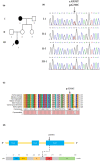Identification of a novel heterozygous SOX9 variant in a Chinese family with congenital heart disease
- PMID: 35218327
- PMCID: PMC9034670
- DOI: 10.1002/mgg3.1909
Identification of a novel heterozygous SOX9 variant in a Chinese family with congenital heart disease
Abstract
Background: Previous studies of individuals with hereditary or sporadic congenital heart disease (CHD) have provided strong evidence for a genetic basis for CHD. The aim of this study was to identify novel pathogenic genes and variants in a Chinese CHD family.
Methods: Three generations of a family with CHD were recruited. We performed whole exome sequencing for the affected individuals and the proband's unaffected aunt to investigate the genetic causes of CHD in this family. Heterozygous variants carried by the proband and her maternal grandmother, but not the proband's aunt, were selected. The frequencies of the variants detected were assessed using public databases, and their influences on protein function were predicted using online prediction software. The candidate variant was further confirmed by Sanger sequencing of other members of the family.
Results: On the basis of the family's pedigree, the mode of inheritance was speculated to be autosomal dominant with incomplete penetrance. We identified a novel heterozygous missense variant in SOX9 in all affected individuals and one asymptomatic family member, suggesting an inheritance pattern with incomplete penetrance. The variant was not found in any public database. In addition, the variant was highly conserved among mammals, and was predicted to be deleterious by online software programs.
Conclusions: We report for the first time a novel heterozygous missense variant in SOX9 (NM_000346:c.931G>T:p.Gly311Cys) in a Chinese CHD family. Our results provide further evidence supporting a causative role for SOX9 variants in CHD.
Keywords: SOX9; congenital heart disease; incomplete penetrance; missense variant; whole exome sequencing.
© 2022 The Authors. Molecular Genetics & Genomic Medicine published by Wiley Periodicals LLC.
Conflict of interest statement
The authors declare that they have no conflict of interest.
Figures


Similar articles
-
Whole-exome sequencing of pathogenic genes in a family with congenital heart disease: A case report.Medicine (Baltimore). 2024 Feb 2;103(5):e36977. doi: 10.1097/MD.0000000000036977. Medicine (Baltimore). 2024. PMID: 38306576 Free PMC article.
-
Case Report: Tetralogy of Fallot in a Chinese Family Caused by a Novel Missense Variant of MYOM2.Front Cardiovasc Med. 2022 Jul 7;9:863650. doi: 10.3389/fcvm.2022.863650. eCollection 2022. Front Cardiovasc Med. 2022. PMID: 35872890 Free PMC article.
-
DNAH11 compound heterozygous variants cause heterotaxy and congenital heart disease.PLoS One. 2021 Jun 16;16(6):e0252786. doi: 10.1371/journal.pone.0252786. eCollection 2021. PLoS One. 2021. PMID: 34133440 Free PMC article.
-
A de novo low-frequency mosaic variant of KIF1A causes hereditary spastic paraplegia: A literature review.Ann Hum Genet. 2023 Jul;87(4):158-165. doi: 10.1111/ahg.12503. Epub 2023 Mar 10. Ann Hum Genet. 2023. PMID: 36896784 Review.
-
More autosomal dominant SPG18 cases than recessive? The first AD-SPG18 pedigree in Chinese and literature review.Brain Behav. 2021 Dec;11(12):e32395. doi: 10.1002/brb3.2395. Epub 2021 Nov 3. Brain Behav. 2021. PMID: 34734492 Free PMC article. Review.
Cited by
-
Discovery of GJC1 (Cx45) as a New Gene Underlying Congenital Heart Disease and Arrhythmias.Biology (Basel). 2023 Feb 21;12(3):346. doi: 10.3390/biology12030346. Biology (Basel). 2023. PMID: 36979038 Free PMC article.
-
Identification and genetic analysis of rare variants in myosin family genes in 412 Han Chinese congenital heart disease patients.Mol Genet Genomic Med. 2022 Oct;10(10):e2041. doi: 10.1002/mgg3.2041. Epub 2022 Aug 22. Mol Genet Genomic Med. 2022. PMID: 35993536 Free PMC article.
-
AOP Report: Aryl Hydrocarbon Receptor Activation Leads to Early-Life Stage Mortality via Sox9 Repression-Induced Craniofacial and Cardiac Malformations.Environ Toxicol Chem. 2023 Oct;42(10):2063-2077. doi: 10.1002/etc.5699. Epub 2023 Aug 2. Environ Toxicol Chem. 2023. PMID: 37341548 Free PMC article.
-
Sox9 in the second heart field and the development of the outflow tract; implications for cardiac septation and valve formation.Dev Dyn. 2025 Mar 26:10.1002/dvdy.70014. doi: 10.1002/dvdy.70014. Online ahead of print. Dev Dyn. 2025. PMID: 40135884 Free PMC article.
References
-
- Abid, D. , Elloumi, A. , Abid, L. , Mallek, S. , Aloulou, H. , Chabchoub, I. , Bouraoui, A. , Thabet, A. , Gargouri, L. , Zribi, M. , Yaich, S. , Hachicha, M. , Gargouri, A. , Mahfoudh, A. , Maatoug, S. , Dammak, J. , & Kammoun, S. (2014). Congenital heart disease in 37,294 births in Tunisia: Birth prevalence and mortality rate. Cardiology in the Young, 24(5), 866–871. 10.1017/S1047951113001194 - DOI - PubMed
-
- Akiyama, H. , Chaboissier, M. C. , Behringer, R. R. , Rowitch, D. H. , Schedl, A. , Epstein, J. A. , & de Crombrugghe, B. (2004). Essential role of Sox9 in the pathway that controls formation of cardiac valves and septa. Proceedings of the National Academy of Sciences of the United States of America, 101(17), 6502–6507. 10.1073/pnas.0401711101 - DOI - PMC - PubMed
-
- Bakker, M. K. , Bergman, J. E. H. , Krikov, S. , Amar, E. , Cocchi, G. , Cragan, J. , de Walle, H. E. K. , Gatt, M. , Groisman, B. , Liu, S. , Nembhard, W. N. , Pierini, A. , Rissmann, A. , Chidambarathanu, S. , Sipek, A. , Szabova, E. , Tagliabue, G. , Tucker, D. , Mastroiacovo, P. , & Botto, L. D. (2019). Prenatal diagnosis and prevalence of critical congenital heart defects: An international retrospective cohort study. BMJ Open, 9(7), e028139. 10.1136/bmjopen-2018-028139 - DOI - PMC - PubMed
Publication types
MeSH terms
Substances
LinkOut - more resources
Full Text Sources
Medical
Research Materials

